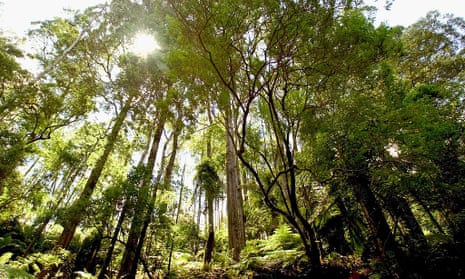Victoria’s publicly owned forestry agency has been allowed to restart logging in bushfire-ravaged east Gippsland despite a warning from a regulator there was a risk of “serious and irreversible damage” to the state’s biodiversity.
A report released under freedom of information laws show the state’s conservation regulator twice wrote to VicForests during and after last summer’s catastrophic bushfires advising it should apply the “precautionary principle” when logging in the area.
An initial letter in January suggested that logging should be modified “in response to the changed conditions for vulnerable and threatened species across the state”. A follow-up in February said the scale of the damage meant it was justified to stop commercial logging until there was more information that reduced scientific uncertainty about the risk of permanent damage.
VicForests met regularly with the office of the regulator over the following months before restarting logging with its approval in June, having developed what it described as “an alternative approach that achieved an equivalent level of protection” for at-risk species.
Environmentalists said neither the agency nor the regulator had adequately explained how the concerns raised by the conservation regulator had been addressed. They called for logging to stop while a “major event review” of fire-affected forests, announced by the state government last week, was carried out.
“It’s madness. I just don’t understand how they can justify continuing to log,” said Chris Schuringa, a campaigner with the Goongerah Environment Centre, who lodged the freedom-of-information request.
About 1.5m hectares burned in Victoria last summer, most of it in east Gippsland. The state government says at least 244 animal and plant species had half or more of their known habitat affected by fire. More than 200 of the species are considered rare or threatened.
VicForests said it sought advice from the regulator about steps it should take to allow forestry while the impact of the bushfires was being assessed.
“This approach included delaying all harvesting in east Gippsland for six months, and the use of thorough habitat surveys and additional protections for priority habitat as harvesting has resumed,” an agency spokesperson said.
The regulator’s report said VicForests had decided to apply “important precautionary measures” including restricting harvesting to fire-killed stands of ash species, retaining all green patches, and all live trees and dead large hollow trees where safe to do so.
Schuringa said there had not been a satisfactory explanation of how this satisfied the precautionary principle, or how the environment department was monitoring logging.
“We aren’t seeing any changes on the ground and there hasn’t really been any indication from the department about what they are doing,” she said.
A Victorian government spokesperson said the conservation regulator, which sits within the state environment department, had been monitoring compliance with the law.
They said all forestry in east Gippsland must adhere to the 2014 code of practice for timber production, including the requirements of the precautionary principle.
But the conservation regulator report released under FOI laws said the fires had created uncertainty over whether the existing code requirements and management were enough to maintain biological diversity within the state’s forests.
Announcing the review last week, the Andrews government said it would look at what remedial action was needed to ensure forests “continue to be managed appropriately”.
It said the review was made possible by a change to the regional forestry agreement between the commonwealth and state, and would be led by an independent panel informed by “scientific data and research, Traditional Owner knowledge, forest experts and communities”.
In a separate statement last week, the government announced $2.5m in grants for “salvage logging” of 125,000 “green tonnes” of timber – mainly native ash species and plantations – in burned areas. The agriculture minister, Jaclyn Symes, said no logging would be allowed this year in unburnt areas that fell “within the fire footprint”. It is expected some of these areas will be made available to VicForests next year.
The backdrop to the dispute over whether logging should stop in east Gippsland is an announcement by the Victorian government last year that it would start to wind down native forestry logging from 2024 and ban the practice by 2030.
It announced 90,000 hectares of old-growth forest would be immediately protected and another 96,000 hectares set aside to save the threatened greater glider. Daniel Andrews said a $120m package for businesses and workers affected by the ban would start in 2024.
At the time, the premier warned native timber supply was already down about 50% in a decade, and that a large bushfire might hasten the industry’s end. He reiterated the point on ABC radio as bushfires burned in January.
The forestry industry is campaigning against the ban. The Construction, Forestry, Maritime, Mining and Energy Union last week met with workers in the eastern timber towns of Healesville, Heyfield and Orbost.
Its manufacturing division secretary, Michael O’Connor, has called the ban ideological, cruel and irresponsible and said it would put regional Victorians out of work. He is in Canberra this week lobbying federal MPs.
Tim Beshara, from the Wilderness Society, said the state review was important and all logging in unburnt and adjoining burnt forests should stop until it was completed.
“Letting VicForests be the arbiter of working out when it is safe to log in bushfire-affected areas is a surefire path to extinction of our forest fauna,” he said.
The federal court last year ruled VicForests logging in the state’s central highlands had breached the code relating to threatened species. The judgment has challenged the forestry industry’s effective exemption from being assessed under national environment laws. VicForests is appealing the decision.
